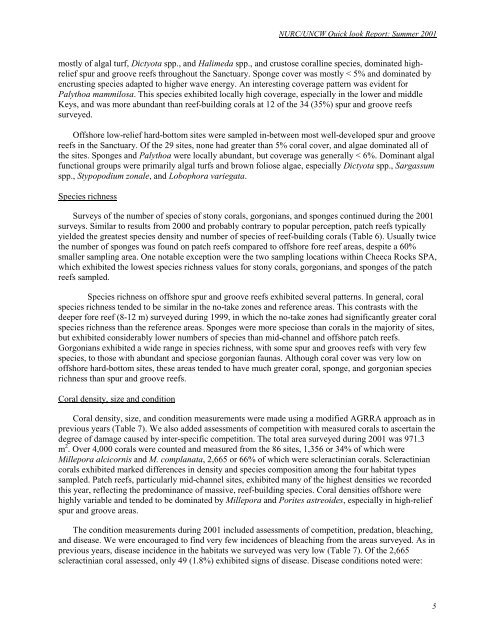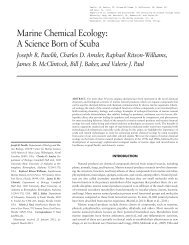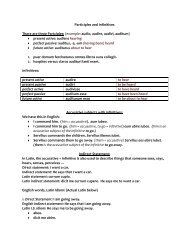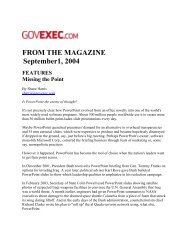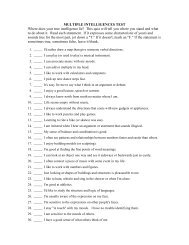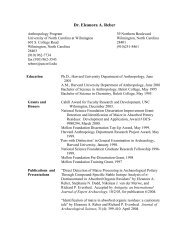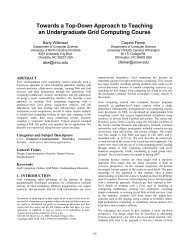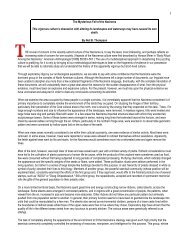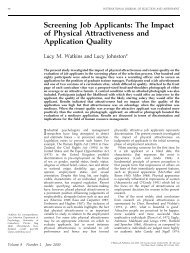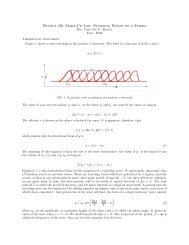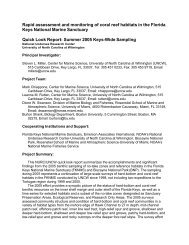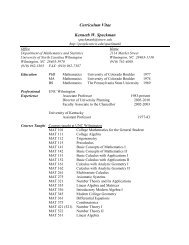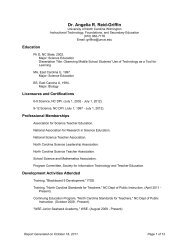Quicklook Report 2001 - People Server at UNCW
Quicklook Report 2001 - People Server at UNCW
Quicklook Report 2001 - People Server at UNCW
Create successful ePaper yourself
Turn your PDF publications into a flip-book with our unique Google optimized e-Paper software.
NURC/<strong>UNCW</strong> Quick look <strong>Report</strong>: Summer <strong>2001</strong><br />
mostly of algal turf, Dictyota spp., and Halimeda spp., and crustose coralline species, domin<strong>at</strong>ed highrelief<br />
spur and groove reefs throughout the Sanctuary. Sponge cover was mostly < 5% and domin<strong>at</strong>ed by<br />
encrusting species adapted to higher wave energy. An interesting coverage p<strong>at</strong>tern was evident for<br />
Palythoa mammilosa. This species exhibited locally high coverage, especially in the lower and middle<br />
Keys, and was more abundant than reef-building corals <strong>at</strong> 12 of the 34 (35%) spur and groove reefs<br />
surveyed.<br />
Offshore low-relief hard-bottom sites were sampled in-between most well-developed spur and groove<br />
reefs in the Sanctuary. Of the 29 sites, none had gre<strong>at</strong>er than 5% coral cover, and algae domin<strong>at</strong>ed all of<br />
the sites. Sponges and Palythoa were locally abundant, but coverage was generally < 6%. Dominant algal<br />
functional groups were primarily algal turfs and brown foliose algae, especially Dictyota spp., Sargassum<br />
spp., Stypopodium zonale, and Lobophora varieg<strong>at</strong>a.<br />
Species richness<br />
Surveys of the number of species of stony corals, gorgonians, and sponges continued during the <strong>2001</strong><br />
surveys. Similar to results from 2000 and probably contrary to popular perception, p<strong>at</strong>ch reefs typically<br />
yielded the gre<strong>at</strong>est species density and number of species of reef-building corals (Table 6). Usually twice<br />
the number of sponges was found on p<strong>at</strong>ch reefs compared to offshore fore reef areas, despite a 60%<br />
smaller sampling area. One notable exception were the two sampling loc<strong>at</strong>ions within Cheeca Rocks SPA,<br />
which exhibited the lowest species richness values for stony corals, gorgonians, and sponges of the p<strong>at</strong>ch<br />
reefs sampled.<br />
Species richness on offshore spur and groove reefs exhibited several p<strong>at</strong>terns. In general, coral<br />
species richness tended to be similar in the no-take zones and reference areas. This contrasts with the<br />
deeper fore reef (8-12 m) surveyed during 1999, in which the no-take zones had significantly gre<strong>at</strong>er coral<br />
species richness than the reference areas. Sponges were more speciose than corals in the majority of sites,<br />
but exhibited considerably lower numbers of species than mid-channel and offshore p<strong>at</strong>ch reefs.<br />
Gorgonians exhibited a wide range in species richness, with some spur and grooves reefs with very few<br />
species, to those with abundant and speciose gorgonian faunas. Although coral cover was very low on<br />
offshore hard-bottom sites, these areas tended to have much gre<strong>at</strong>er coral, sponge, and gorgonian species<br />
richness than spur and groove reefs.<br />
Coral density, size and condition<br />
Coral density, size, and condition measurements were made using a modified AGRRA approach as in<br />
previous years (Table 7). We also added assessments of competition with measured corals to ascertain the<br />
degree of damage caused by inter-specific competition. The total area surveyed during <strong>2001</strong> was 971.3<br />
m 2 . Over 4,000 corals were counted and measured from the 86 sites, 1,356 or 34% of which were<br />
Millepora alcicornis and M. complan<strong>at</strong>a, 2,665 or 66% of which were scleractinian corals. Scleractinian<br />
corals exhibited marked differences in density and species composition among the four habit<strong>at</strong> types<br />
sampled. P<strong>at</strong>ch reefs, particularly mid-channel sites, exhibited many of the highest densities we recorded<br />
this year, reflecting the predominance of massive, reef-building species. Coral densities offshore were<br />
highly variable and tended to be domin<strong>at</strong>ed by Millepora and Porites astreoides, especially in high-relief<br />
spur and groove areas.<br />
The condition measurements during <strong>2001</strong> included assessments of competition, pred<strong>at</strong>ion, bleaching,<br />
and disease. We were encouraged to find very few incidences of bleaching from the areas surveyed. As in<br />
previous years, disease incidence in the habit<strong>at</strong>s we surveyed was very low (Table 7). Of the 2,665<br />
scleractinian coral assessed, only 49 (1.8%) exhibited signs of disease. Disease conditions noted were:<br />
5


